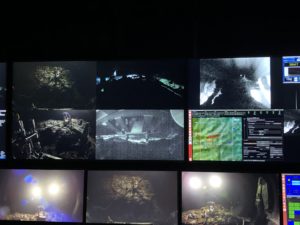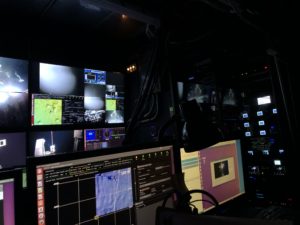
I got to sleep in today which was really nice. Around noon, Rob Fatland did a mini-talk about the carbon cycle and Katie Bigham did a science talk about her Ph.D project. It was really cool to hear about her research. She’s studying a deep sea canyon off New Zealand, with one of the world’s most rich and diverse life, before and after an earthquake. There was almost no life after the event which was sad, but it seems like it’s slowing coming back now. I think it’s really awesome that Katie B. is able to study this one piece of ocean and see how it changes. I think NSF should fund more projects that are simply about exploring the ocean and finding more amazing hidden ecosystems like this canyon environment.

Afterwards, I talked to Trina a little bit about my project. I would love to learn more about the APL and what she does and I’m super excited for the science talk she’s planning to give us in a couple days.
Now that I no longer have shifts in the ROV control room, I regret that I didn’t talk to the Jason crew as much as I could’ve. Jason is so interesting and there’s a lot to learn there. It looks like an exciting place to work.
After dinner, I helped Julie do some tests to find out how much chlorophyll was in the samples we collected earlier. We had to turn off the lights to make sure our measurements were as accurate as possible. I finished up the night by helping assemble the RAS-PPS Instrument and working on the presentation for my project.

Today we saw some more sample collecting from the NASA InVADER team. We went to a chimney called Hell. Pablo, the lead of the team, was super excited about the rocks he was collecting, which made logging fun. I didn’t realize it, but that shift was actually my last in the control room.
After my shift ended, I spent some time decorating a foam owl that was going to go down in an instrument called a CTD rosette. The CTD rosette is an instrument that collects samples from different depths of water.

It’s been a tradition for these cruises to have all the scientists decorate foam pieces, put them in a bag, and attach it to the CTD rosette when it goes down to about 2600 m. The pressure deforms/shrinks the styrofoam into interesting versions of the regular pieces.
Everyone seemed a little lighter now that regular scientific operations are done. It was fun having a little bit of free time and getting to talk with people a little bit more. We waited in the computer lab and got to talk to the winch operator over radio as they lowered the CTD rosettes to specific depths.

Once it reached a certain depth, we would click a button to "fire" one of the bottles and capture a sample. We spent the rest of the night waiting for the rosette to surface and then collecting it and storing all the samples away. It was late in the night before I went to bed, but it felt good to help out and learn something new. I’ll get to sleep in today since there’s no morning shift tomorrow so I’m excited.

August 30: Sampling the Deep
This morning, the Invader team from NASA collected solid samples from a chimney called Phoenix in the ASHES Hydrothermal Field as part of a project funded by BOEM (D. Kelley PI). Their largest samples was about 50 pounds in water weight, which is about 100 pounds on land. Their project is really cool and the people working on it are super nice too. They are trying to collect data about the vents and how they can sustain life so that this knowledge can eventually help them understand more about potential life on other watery planets/moons.
There were a few worms that survived the journey up from about 1500 m below the ocean surface. They were still alive, but won’t survive long because our environment on land does not fit their preferred high-pressure underwater vent environment. I feel bad for the worms, but I hope that the InVADER team can use these samples to potentially find other similar creatures on other planets.
During my night shift in the Jason control van, something kinda scary happened. On Jason’s navigational panel, it looked like the ship was taking off at about 7 knots and abandoning Jason. It was a little hectic in the room for a second until they were able to figure out that the navigational feed they were getting
was noy good. I’m not sure why that happened, but it was kinda wild. It reminded me how crazy this entire mission is and how incredible it is that the laws of nature allow underwater robots and cabled arrays and these complicated instruments to actually work.
Even when we like to think we’ve learned the rules and laws of the world, there’s always something that we’ll never quite understand. I think that’s what keeps this expedition so exciting.

August 29: Diving at the Vents
Today was a pretty eventful day! We got to see some pretty chimneys and an underwater camera covered in white fuzzy stuff after living in the ocean for a bit. It’s weird how these animals that have rarely seen the light of day adapt so quickly
to these alien objects that come into their homes.
Afterwards, I finally got a chance to talk to some engineers! I talked briefly to some people from the Jason team during lunch and then got to talk to some Applied Physics Laboratory engineers. I asked if I could help out with some electrical engineering tests, but they are, unfortunately, done with most of them. However, they were really nice and gave me a great idea for a potential project I could do that could involve some electronic communications topics.
They suggested I talk to Rob (who does cloud computing research at the UW), so I talked to him and learned about instruments called hydrophones, which are underwater sensors on the cabled array that pick up noise signals (listen to) that include whale songs or ships passing by.
Rob’s team is working on using machine learning to go through these data automatically and identify what time whales might’ve passed by. I’m still not sure where to even find these data, but I’ve started looking through a site summary book of deployed instruments and learning more about where they’re located.

There are some other really cool instruments I came across too like seisometers and something called a Horizontal Electric Field, Pressure, and Inverted Echo Sounder. When things are less busy, I want to try to talk to Tina (an instrumentation lead at
the APL) to learn more about them. I’d also love to learn more about the APL
in general because it seems like such a cool place to work.
It would also be really great to learn more about Jason and how it’s able to communicate with the ship while it’s underwater! There’s a lot of interesting stuff going on here.
In the evening, I helped Andrew clean out some sample bottles and then he showed Delilah, Cathe, and I how to make a really strong loop of rope which was awesome.
During my night shift I saw a fish called a Sculpin and got to see more vents. Sometimes when there are specks of white floating around in the deep blue waters, it looks like we’re looking at a sky of stars.

Though, I definitely should’ve started talking to these engineers earlier, I’m happy that I finally worked up the courage to talk to some more people and glad I got to learn a lot today. I always get anxious before talking to new people and wonder if I’m asking stupid questions so today was just another reminder that people are usually pretty nice and willing to help out and that I shouldn’t be afraid to take up my own space. I’m really excited to learn more.

that all comes together.

August 27: First Shift in the ROV Control Van
This morning, we made a short transit to the Axial Eastern Caldera site. During my morning shift in the ROV control center, I got my first glimpse of the ocean floor! Not just any ocean floor – we were looking at rocks called "pillow basalts" in the middle of an active underwater volcano!
Afterwards, I did some research on what kind of project I might be able to do that could involve something I’m interested in called a software defined radio.

Most of my night shift was watching Jason climb up the water column so I chatted with my shift partner Cathe for a bit. I’m a senior and I have no idea what I want to do after I graduate so it was really cool to hear about how Cathe went from being a mathemetical programmer to an artist. I’d love to hear about the journey that other people on this boat have taken to end up here!
August 24-25: Getting Used to the Ship
I haven’t written much in the last couple of days because I’ve been trying to get used to the motion of the ship. After taking a quick nap in the morning
and sipping on some Ginger Ale, I feel much better.
On the night of August 25th, we stopped at the Oregon Offshore Site. It was my first time logging for the Jason control center. Jason is the remote operated underwater vehicle that helps our team complete various scientific tasks during dives. It was actually really fun keeping track of what was happening in the dive!

It didn’t feel like I was just passively watching the live stream of Jason play out, I actually felt like part of the team and also got to see how the ROV operators and scientists worked together to complete tasks for the dive. It was really exciting getting a "secret" glimpse into the exciting world of underwater science missions!
One thing that’s astounded me since I got here is how kind and patient everyone is to each other on the ship, even when stakes are high. In the control van, people were frustrated when a certain operation was taking longer than expected, but everyone still worked really well together.

On the night of August 24th, while we were still in port, I spent a few hours playing
a board game with some really amazing women and I really felt honored to be part of this ship of scientists, engineers, and generally important people. I’m excited for what else I’ll get to learn during the rest of the cruise and I hope I’ll get to work with some more of the amazing people around the ship in the near future.

